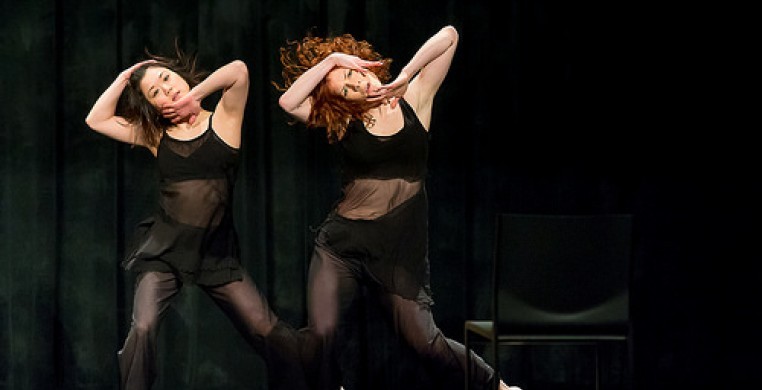Silence, minimalism, and a beam of light catching stray angles of flesh against pervasive darkness make you want to watch, and to watch very carefully, right from the start of Heidi Latsky Dance’s “One Hour: Two Works” (Nov. 6-8, The Dance Center, Columbia College). And that’s Latsky’s whole point, to give us a way to see unique variations of unique human bodies in unexpected possibilities.
Pre-performance publicity alerted us that Latsky’s troupe included “mixed-ability” dancers. That could be a tip-off for “disabled but sincere,” or “some more ‘able’ than others.” Fortunately, neither is the case, for Latsky’s troupe, diverse in unconventional ways to be sure, is comprised first and foremost of highly capable dancers. Latsky, a former dancer with the Bill T. Jones/Arnie Zane Dance Company, sees differences we often categorize as disabilities, such as deafness, Parkinson’s disease, and cerebral palsy, as no more limiting than hyper-mobility, deviations in size, or advanced age. She capitalizes on the opportunities they offer to choreograph to her own and her dancers’ unique strengths, hoping that audiences “will enjoy their unique beauty and walk away uplifted and energized and moved.” She also hopes to inspire us to rethink our preconceived notions of what a dancer is.
Of the two pieces on the program, “Solo Countersolo” (2013), and “Somewhere” (2013), the latter most clearly demonstrates Latsky’s aims. Both pieces use Christopher Ash’s stark lighting specials to sharply delineate space and isolate movement against a black backdrop, creating the existential reality of a timeless vacuum which dancers enter and exit. In both pieces, the dancers remain in Carlos Arias’s costume variations on a theme of black, defining both individuality and commonality.
“Solo Countersolo” (2013), serves as an introduction to Heidi Latsky Dance, and a sampler of her choreographic style. It opens with Latsky fully lit and activated at the center of a partially obscured, shoulder-to-shoulder line-up of two men and three additional women. Like figures in an automated shooting gallery, the five dancers randomly shift facings with minute, infrequent adjustments, revealing the shaft of an arm, the sliver of a profile, the bare skin of different body parts glowing in almost iridescent golden relief against the black space. Their stillness and anonymity contrast with Latsky’s hip swivels and straight-arm whips, body dips and pulsing suspensions, a highly personalized, emotional exorcism. Chris Brierley’s strident string music, commissioned for the piece, builds tension and urgency as Latsky repeats a single movement phrase that intensifies and develops in range, speed, and effort with the music. The corps de ballet to either side remains still, with an occasional angular version of a fourth position preparation and pirouette, mirroring Latsky’s straight-arm slices and whipping body spirals. Latsky’s movement becomes increasingly agitated. She steps briefly out of her pattern to press her body against a female corps dancer’s body, a moment of contact that portends drama that never ensues. The corps exits, leaving Latsky alone on stage in a frenzy, reactivating her repetitive phrase. After a black-out, softer, gentler keyboard music introduces a trio of women, then a duet of men, then a trio of two men partnering Latsky in a series of elegant lifts. The corps, now fully activated, crosses on and off stage with long, low dips, stretches to the floor, and angular pirouettes. Playing slow movement against relentlessly driven music, an occasional high release of the chest arrests their locomotion with outstretched arms, arched neck and head pitched to the ceiling. The signature straight arm swings and slices propel spiral turns, emboitées, jetés en tournants, and piqué turns.
While Latsky is older than the corps dancers in this piece, her age has little impact, and perhaps that is her point. She is, in middle age, lithe, expressive and as fully mobile as her geometric choreography demands. But then so was Galina Ulanova, who performed Romeo and Juliet at 52. Margot Fonteyn was 42 when she danced Giselle with Rudolph Nureyev, and didn’t retire from the stage until the age of 61. And Martha Graham, God love her, was 76 at her final performance in “Cortege of Eagles.” Advanced age may be a stroke of good luck, determination, and artistry, but it is nothing new on the concert dance stage.
On the other hand, Latsky’s “Somewhere,” which implements many permutations of the song, “Over The Rainbow,” is an inspired use of diverse bodies and movement attributes to depict the human longing for transcendence. Here she taps the unique beauty of a bent body and uneven gait, the incredibly poignant impact of a seated man opening his arms in a salutation to existence, the stunning silence and physical power of the song in American Sign Language, the out-sized gyrating jive energy of a big woman with big feelings about rainbows, the loneliness of longing in a man’s solo plea for deliverance, and the intimacy of a man and woman flying over that rainbow together. Now that’s different!
